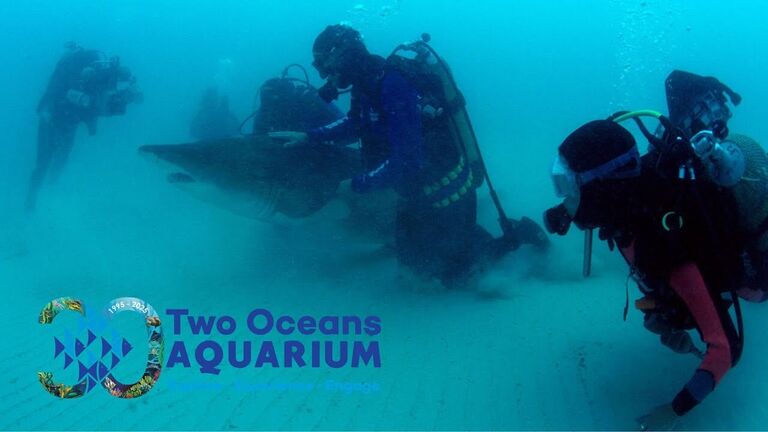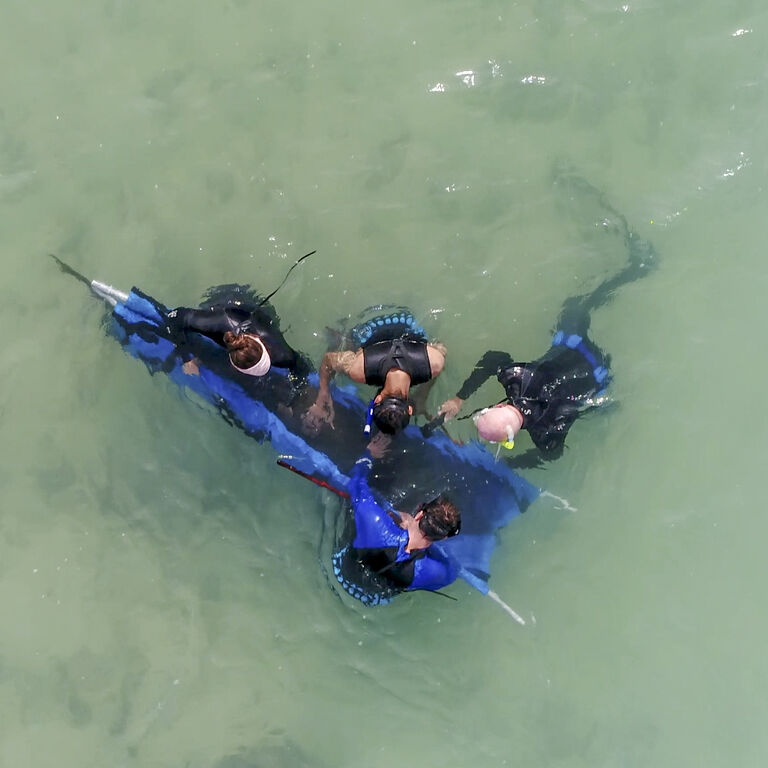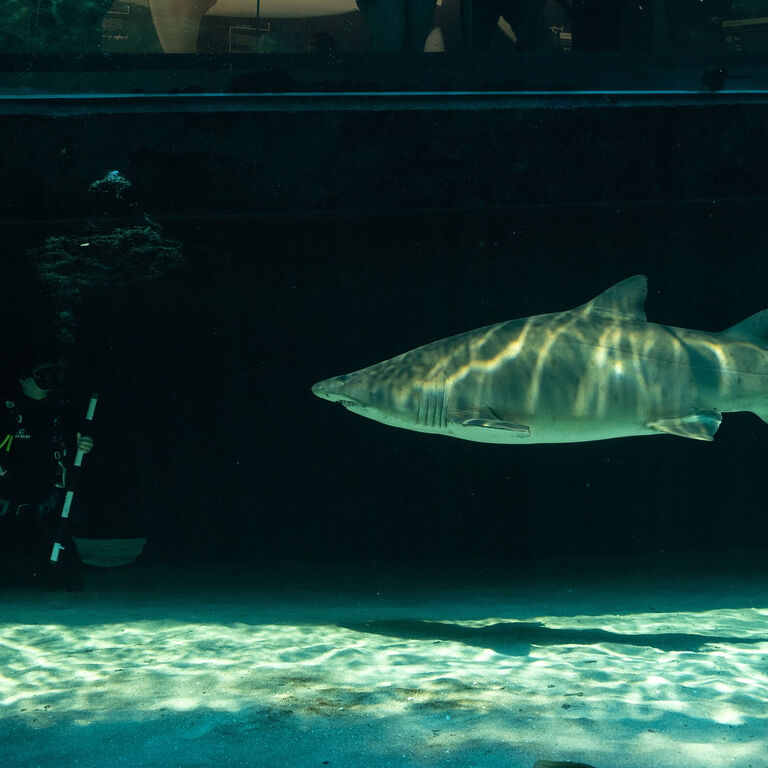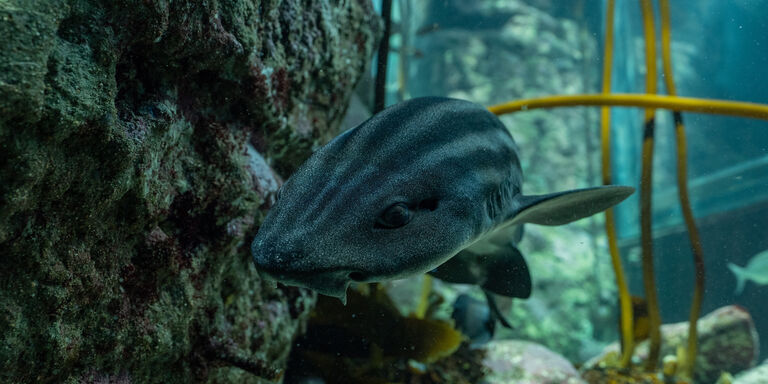
The southern tip of the African continent is the meeting place of two mighty and bountiful oceans, the Indian and the Atlantic. The Two Oceans Aquarium on the V&A Waterfront, Cape Town, is ideally positioned to showcase the incredible diversity of marine life found off the southern tip of Africa.
The Two Oceans Aquarium is dedicated to informing and inspiring all to connect with and protect our ocean and the natural world through conservation, awareness, research, and education.
Quick facts
General:
- South Africa is home to over 100 species of sharks – about a quarter of the world’s shark diversity.
- More than a third of South Africa's shark species are at risk of extinction.
- The longest shark migration recorded is 32 000km - between South Africa and Australia.
- Shark skin is covered in tiny, tooth-like armoured plates called "dermal denticles".
- Sharks are elasmobranchs - this means their skeletons are made entirely of cartilage.
Ragged-tooth sharks:
- Ragged-tooth sharks are listed as critically endangered on the IUCN Red List of Threatened Species.
- Ragged-tooth sharks inhabit sandy coastal areas, estuaries, tropical reefs and other warm and temperate waters around the world.
- Ragged-tooth sharks grow to about 3.2m and can live for 30 years!
- Ragged-tooth sharks are well-suited to Aquarium living and are proven to return to their normal, natural behaviours once they return to the wild.
Misconceptions versus reality
Sharks have long been sensationalised in popular media as mindless killing machines. But this is far from reality. At the Two Oceans Aquarium, we are dedicated to breaking misconceptions about these incredible animals - the Save Our Seas Foundation Shark Exhibit is there to give sharks a voice.
Sharks' role in the ecosystem
Sharks are often regarded as keystone species in their ecosystems. The ocean’s food web is a delicate system that relies on balance to stay healthy, and as top predators, sharks play a vital role by keeping populations of animals lower in the food web in check. By feeding on smaller predators and grazers, they prevent these species from becoming too numerous, allowing even smaller animals to thrive.
Without sharks, mid-level predators (mesopredators) would multiply unchecked and overconsume their prey, causing food shortages that would ultimately harm their own populations. Even the simple presence of sharks helps maintain balance, as their prey often avoids areas where sharks are active, giving smaller species and habitats a chance to recover.
Removing sharks from an ecosystem could therefore result in the loss of essential food resources, job opportunities, and biodiversity, ultimately compromising the ocean’s ability to function as a life-support system for the planet. By protecting and respecting sharks and educating others about their plight, we can safeguard the global marine ecosystem, with clear benefits for both nature and people.
Conservation
Sharks may have a bad reputation, but ours is worse. While annual shark bite incidents are numbered below 100 worldwide, humans kill 75 to 100 million sharks per year. Sharks are killed for their meat, fins, skin, teeth, and cartilage, which are used for merchandise and food, and are often caught as bycatch on large trawling vessels. Many species of shark stand little chance of recovery, as more than a third of all shark species are at risk of extinction. Their typically slow growth, late sexual maturity, and inshore habits make them especially vulnerable to overfishing and population collapse.
In particular, ragged-tooth sharks are regarded as critically endangered by the International Union for Conservation of Nature (IUCN) and globally threatened due to these pressures. For all these reasons, the opportunity to visit and engage with these sharks is extremely informative and well worth it.
Ragged-tooth sharks as ocean ambassadors
At the Two Oceans Aquarium, we typically house three to five ragged-tooth sharks in the Save Our Seas Foundation Shark Exhibit at any time. These sharks serve as ambassadors to create awareness for their species and educate visitors to the Aquarium. The Save Our Seas Foundation Shark Exhibit provides visitors with the rare and exciting opportunity to experience an up-close encounter with these misunderstood "raggies", as they are often called.
The ragged-tooth sharks are only housed in the exhibit for a short period before they are released back into the wild. For almost three decades, the Two Oceans Aquarium has been releasing sharks back into the wild as part of our commitment to ocean conservation and marine education.
We tend to release off Struisbaai at the beginning of the year because ragged-tooth sharks are in the area, and at this time of the year, they migrate up the coast towards KZN. Each shark is tagged before it is released so that the Aquarium and collaborating research institutes can track its movements along the coast. The data collected from tagging is added to the global scientific database around ragged-tooth sharks' movements and lifestyles, and helps us to gain a deeper awareness of how to protect them. These releases are not just about returning animals to their natural habitat; they’re about protecting biodiversity, studying shark behaviour, and inspiring the next generation of ocean guardians.
The sharks are typically tagged with spaghetti tags, which carry a tag number and address. If a fisherman catches a tagged shark, he is encouraged to make a note of the location and date on which he caught the shark and the tag number and also record the length of the shark. He should then send this information to the address on the tag (usually the Oceanographic Research Institute in Durban or Bayworld in Port Elizabeth). When the scientists at these institutes receive the information, they can see how far the shark has travelled and how much it has grown since it was tagged and released.
Frequently Asked Questions
You can watch the ragged tooth sharks being fed every Saturday at 12h00 in the Save our Seas Foundation Shark Exhibit. During the feeding, one of our knowledgeable staff members talks about the sharks, their lifestyles, and why they are such awesome ocean ambassadors.
The Two Oceans Aquarium houses an incredible array of shark species - from the magnificent ragged-tooth sharks to the pretty puffadder shysharks. The Aquarium houses six species of sharks: Ragged-tooth sharks, spotted gully sharks, leopard catsharks, puffadder shysharks, dark shysharks, and pyjama catsharks.
Of the shark species at the Two Oceans Aquarium, the ragged-tooth shark is under the most threat and is listed as Critically Endangered on the IUCN's Red List of Threatened Species.
Yes! The Two Oceans Aquarium's PADI Dive School offers three different, unique, all-weather scuba diving experiences for qualified scuba divers (Open Water-equivalent or higher). You can choose to dive in the Save Our Seas Foundation Shark Exhibitwith our ragged-tooth sharks and an expert guide, no cage required!
Yes, they do. There are currently five beautiful ragged-tooth sharks being housed in the Save Our Seas Foundation Shark Exhibit. Their names are Gemma, Harper, Blue, Charlie, and Tracy-Lee.
- To create awareness about the plight of sharks: Over 100 million sharks are killed around the world every year.
- To change people’s perceptions of sharks: They are not ‘man-eating monsters’, but top predators in the oceans and important for keeping the ecological balance.
- To educate and inspire a love of the ocean: Many of our visitors have never seen a shark in real life - seeing our raggies may inspire a lifelong love of the ocean.









